Celebrating 160 Years: 1863-2023
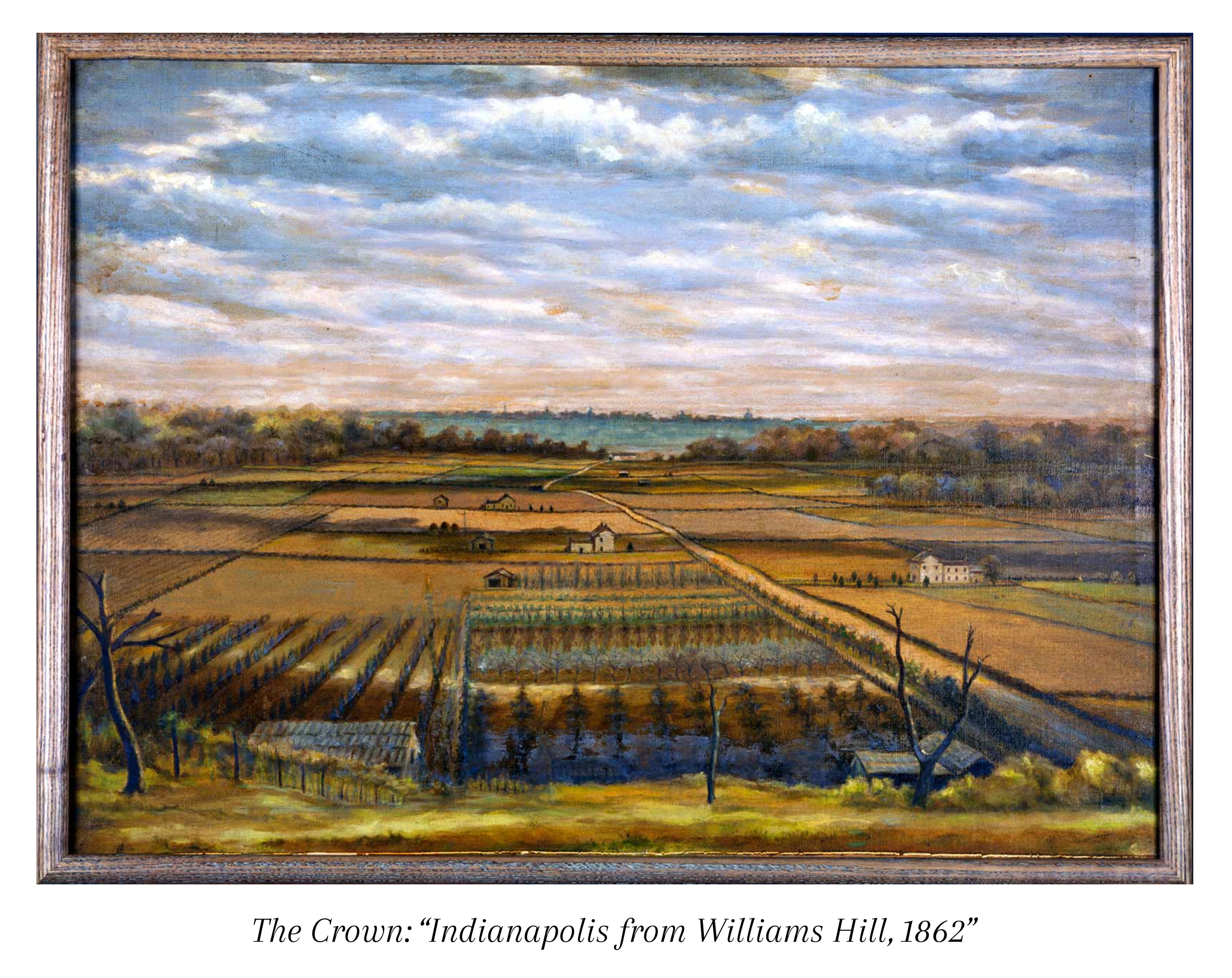 As we celebrate the founding of Crown Hill on September 25, 2023, let’s step back to the beginning with a brief glimpse at our origin and developments over the last 160 years.
As we celebrate the founding of Crown Hill on September 25, 2023, let’s step back to the beginning with a brief glimpse at our origin and developments over the last 160 years.
Crown Hill’s story began around 20,000 years ago, when a melting glacier created a “kame,” a steep-sided mound of sand and gravel — a large hill — that became known as “The Crown.” It rises to 842 feet above sea level and 60 feet above its flat surroundings. In the early 1860s, Martin Williams owned the land, which included this hill, a farm, a tree nursery, and his cabin near the base of the hill.
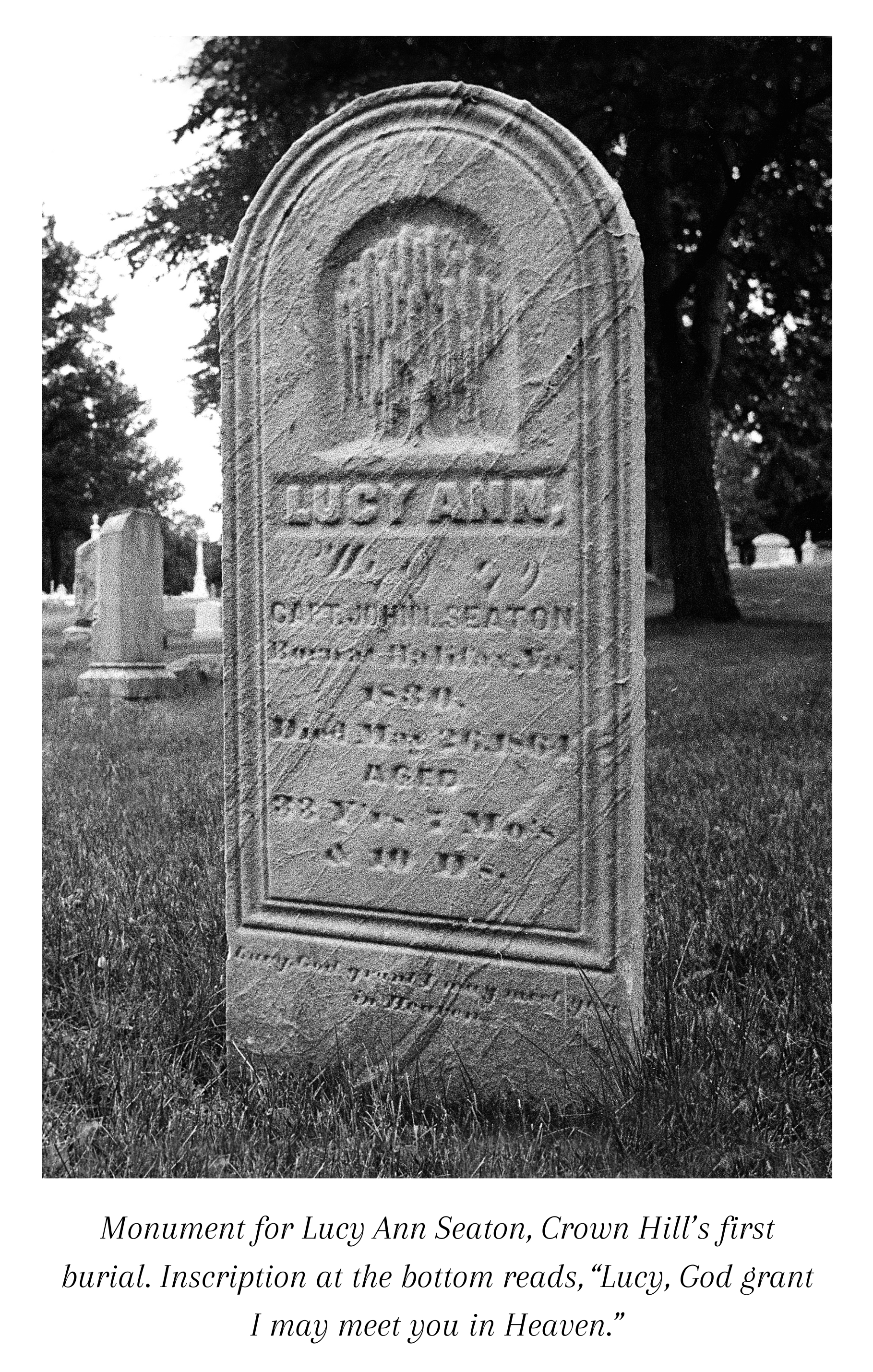 In the summer of 1863, James Ray, an Indianapolis pioneer and civic leader, began pursuing the idea of establishing a Rural Cemetery — landscaped, park-like cemeteries — that became popular in the United States and Europe in the mid-19th century. They were typically built several miles out into the countryside and featured statues and memorials depicting angels and botanical motifs. Before the widespread development of public parks, rural cemeteries provided a place for the public to enjoy outdoor recreation amidst art and sculpture. Ray wanted the new cemetery to take the place of the original City Cemetery, later known as Greenlawn, which was surrounded by railroads and industry and located just outside the southwest corner of Indianapolis’ mile square.
In the summer of 1863, James Ray, an Indianapolis pioneer and civic leader, began pursuing the idea of establishing a Rural Cemetery — landscaped, park-like cemeteries — that became popular in the United States and Europe in the mid-19th century. They were typically built several miles out into the countryside and featured statues and memorials depicting angels and botanical motifs. Before the widespread development of public parks, rural cemeteries provided a place for the public to enjoy outdoor recreation amidst art and sculpture. Ray wanted the new cemetery to take the place of the original City Cemetery, later known as Greenlawn, which was surrounded by railroads and industry and located just outside the southwest corner of Indianapolis’ mile square.
Ray gathered with like-minded city leaders to find the appropriate property for this development. They hired John Chislett, an architect, and Superintendent of Alleghany Cemetery in Pittsburgh, as a consultant. On September 12, 1863, it was unanimously agreed to select suitable grounds within five miles of Indianapolis for a Rural Cemetery of up to 320 acres. In the 1875 book, The Origin, Organization and Management of Crown Hill, James Ray states that on September 15, 1863: “After fruitless searching over miles of level land north of the city, as soon as the nursery hill of Martin Williams caught Chislett’s eye, he at once said to his companions, ‘That is the spot — buy those grounds at whatever price you have to pay.’” Within a week, multiple landowners agreed to sell 240 acres for $50,500 and on September 25, 1863, 30 city leaders signed an agreement to incorporate as “Crown Hill Cemetery.” Additional acres were added through 1911.
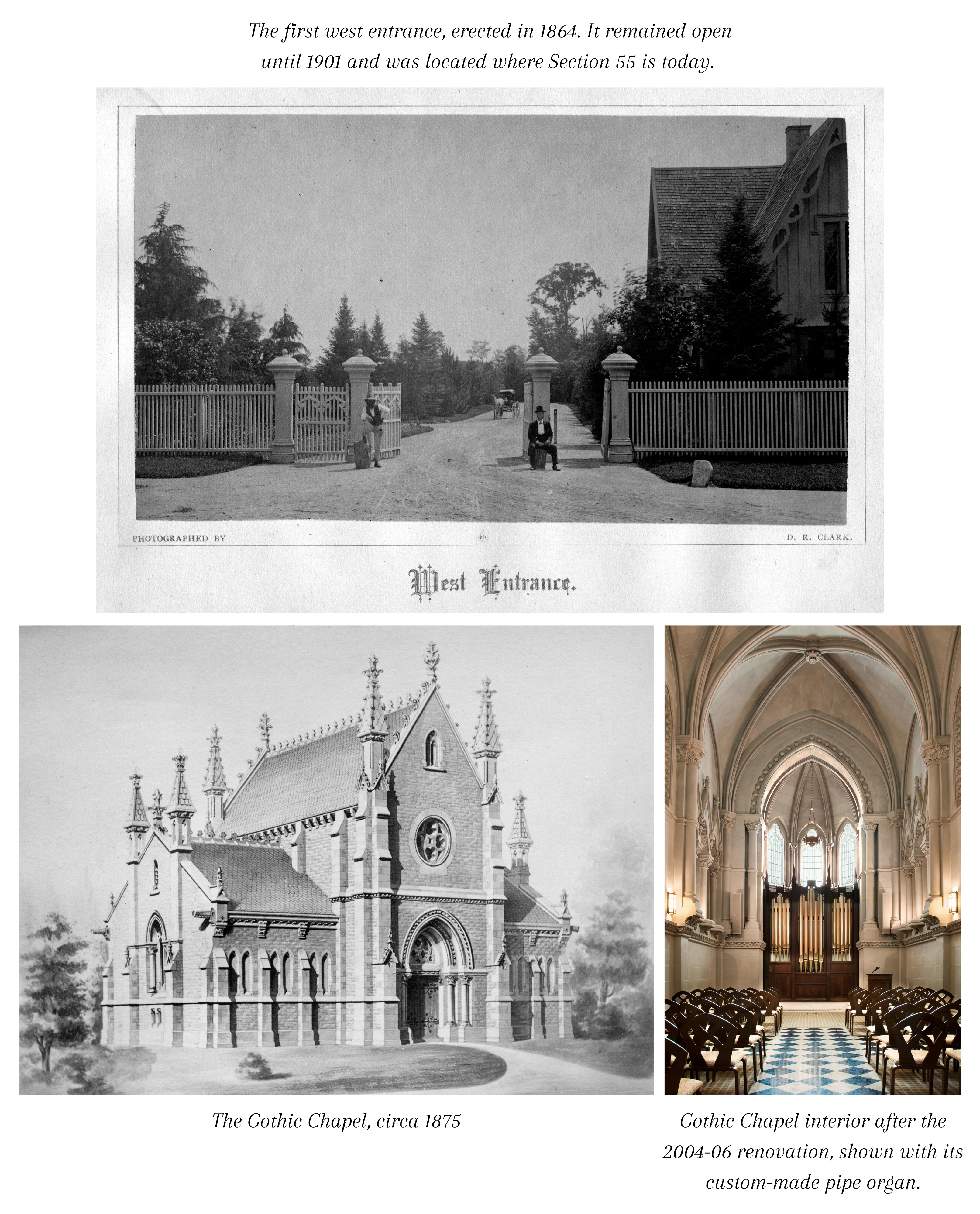
Frederick Chislett, John Chislett’s son, was hired in October 1863 to become the cemetery’s first superintendent, a post he would hold until his death on November 11, 1899, when he was succeeded by his son, also named John, who served until 1910. Frederick and his family had moved into Williams’ cabin on a warm, rainy New Year’s Eve in 1863. When they awoke it was 27 degrees below zero, a historically cold New Year’s Day. By that spring, Frederick began preparing the grounds for its new use as a cemetery.
On June 1, 1864, Crown Hill Cemetery was dedicated with 400 people present. It took visitors hours to arrive, traveling on dirt roads by horse and buggy from Indianapolis, three-and-a-half miles away. Crown Hill’s first burial took place the next day. By placing an announcement in the newspaper, Captain John Seaton, a Union Army Captain from Paducah, Kentucky, invited the public to attend the funeral of his wife, Lucy Ann Seaton, who had died of consumption (Tuberculosis) at age 33. Lucy is buried on Section 4 with her young daughter, also named Lucy, who died five months later. Mrs. Seaton’s burial has been followed by over 225,000 more citizens, representing a cross section of the city’s population from its beginning to the present, with burial space available far into the future.
To meet the growing needs of the cemetery, many structures have been built over the years. Some of them, a home for the superintendent and entrances on the west side of the cemetery, for example, have not survived. Crown Hill’s first main entrance, the “West Entrance,” was built for $2,300 in July 1864 and was replaced in 1901. The second west entrance was used until 1965. Other structures have added to the beauty of the cemetery for nearly 150 years. The Gothic Chapel was designed by architect Dietrich Bohlen and built from Indiana limestone by Peter Routier in 1875 for $38,922.25. Still in use for funerals and other functions, it originally had not only the beautiful central chapel but 96 vaults divided between its two wings where bodies could be temporarily stored. Eli Lilly helped save the building in 1971, and the Crown Hill Foundation raised $2.5 million for a major restoration and the addition of the Vestibule and custom pipe organ in 2004.
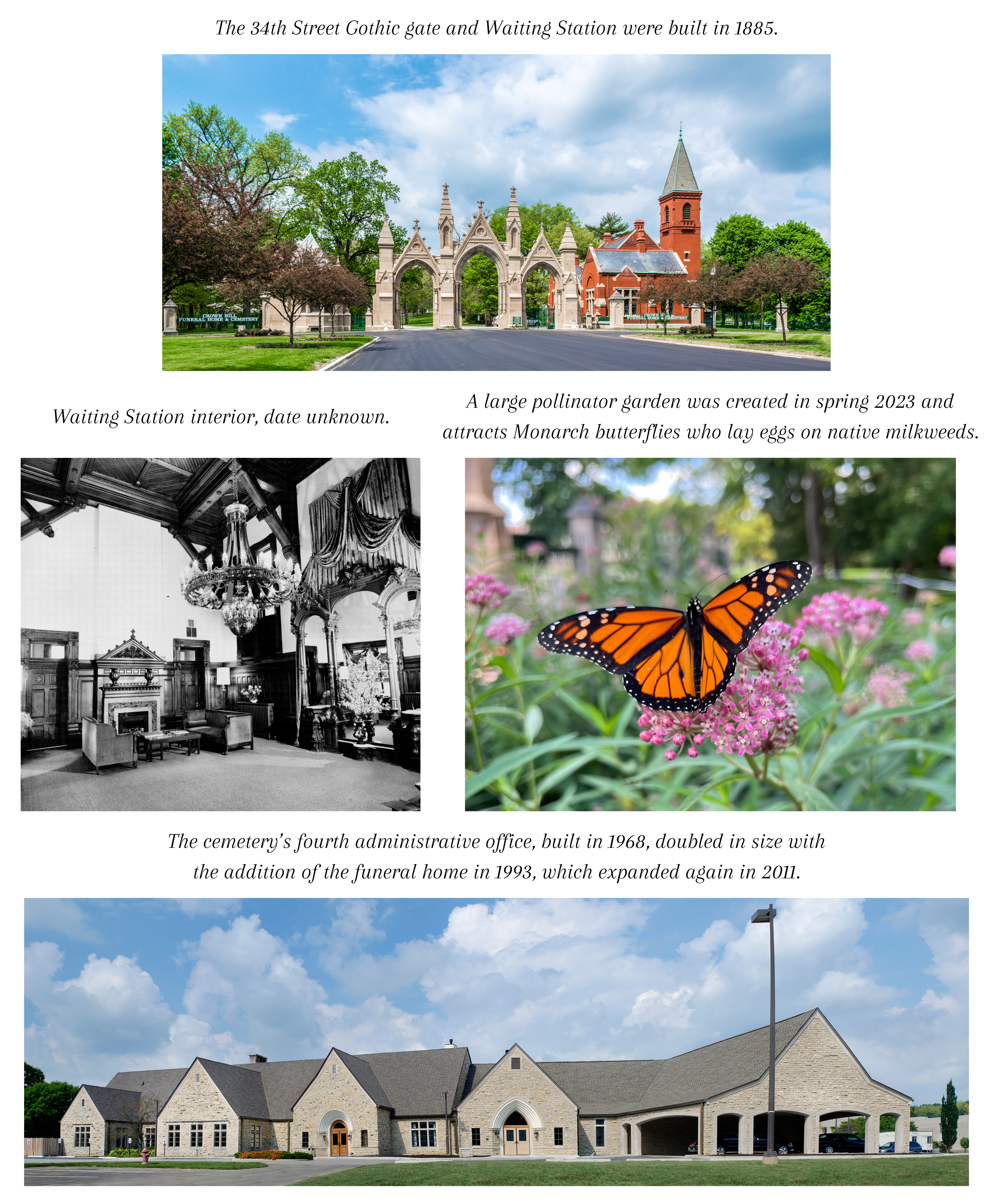 The Waiting Station and its accompanying Gothic Gates at the 34th Street and Boulevard Place entrance were designed by architect Adolph Scherrer and built in 1885. The triple-arched Gothic gates were completed just in time for the funeral procession of Vice President Thomas A. Hendricks on November 30, 1885. A sentry house was added next to the gate in 1904, and a large pollinator garden, shaped like a butterfly wing, was planted next to it last May. For 80 years, the Waiting Station was the cemetery’s business office (the third of four over the years) and provided funeral goers a place to wait for their fellow mourners. This ornate building, with its intricately carved oak and cherry woodwork, also includes a bell tower with a 621-pound bronze bell, cast in 1888 by the Buckeye Bell Foundry in Cincinnati. Today, the Waiting Station is the home of the Crown Hill Foundation, established in 1984 to help “preserve and celebrate the architectural, cultural and natural heritage of the city’s oldest urban green space, Crown Hill Cemetery.” The recent staff additions of an Arborist, responsible for establishing Crown Hill as a Level II Arboretum in the fall of 2022; a Director of Education and Engagement, and a Director of Historic Preservation, are among the ways the Foundation is fulfilling its mission.
The Waiting Station and its accompanying Gothic Gates at the 34th Street and Boulevard Place entrance were designed by architect Adolph Scherrer and built in 1885. The triple-arched Gothic gates were completed just in time for the funeral procession of Vice President Thomas A. Hendricks on November 30, 1885. A sentry house was added next to the gate in 1904, and a large pollinator garden, shaped like a butterfly wing, was planted next to it last May. For 80 years, the Waiting Station was the cemetery’s business office (the third of four over the years) and provided funeral goers a place to wait for their fellow mourners. This ornate building, with its intricately carved oak and cherry woodwork, also includes a bell tower with a 621-pound bronze bell, cast in 1888 by the Buckeye Bell Foundry in Cincinnati. Today, the Waiting Station is the home of the Crown Hill Foundation, established in 1984 to help “preserve and celebrate the architectural, cultural and natural heritage of the city’s oldest urban green space, Crown Hill Cemetery.” The recent staff additions of an Arborist, responsible for establishing Crown Hill as a Level II Arboretum in the fall of 2022; a Director of Education and Engagement, and a Director of Historic Preservation, are among the ways the Foundation is fulfilling its mission.
Built as an extension of the current cemetery administration building constructed in 1968 on the north grounds on the corner of 38th Street and Clarendon Road, the Crown Hill Funeral Home opened in 1993 to provide on-site funeral services. In 2011, it was expanded to include an additional chapel and large reception hall overlooking the cemetery.
The first private family mausoleum was built in the fall of 1864 for the Honorable Caleb B. Smith, a judge who served as President Lincoln’s Secretary of the Interior. For reasons that are still a mystery, Smith, who had died in January 1864, was not entombed in the mausoleum, though it is the final resting place of his son, daughter, and wife. Today, there are 60 private family mausoleums, with several undergoing recent restorations led by the Crown Hill Foundation or family members. The Community Mausoleum north of 38th Street was constructed of Indiana limestone and marble in the early 1950s in the Art Deco style. It was followed by multiple garden mausoleums in the 1960s. More recent garden mausoleums include Field of Valor for military members and their families, and The Pines. A pet cemetery, Companion Meadow, was also added in recent years.
Nationally known city planner and architect George Kessler designed the brick and wrought iron perimeter fence in 1914, replacing the original wooden fence. The approximate three-mile fence took over 20 years to complete. A “subway” (underpass) beneath 38th Street was constructed for $170,000 in 1925, connecting the north and south sides of the cemetery. This summer, visual artists and muralists Tasha Beckwith and Amiah Mims added colorful murals of animals and florals to the structure.
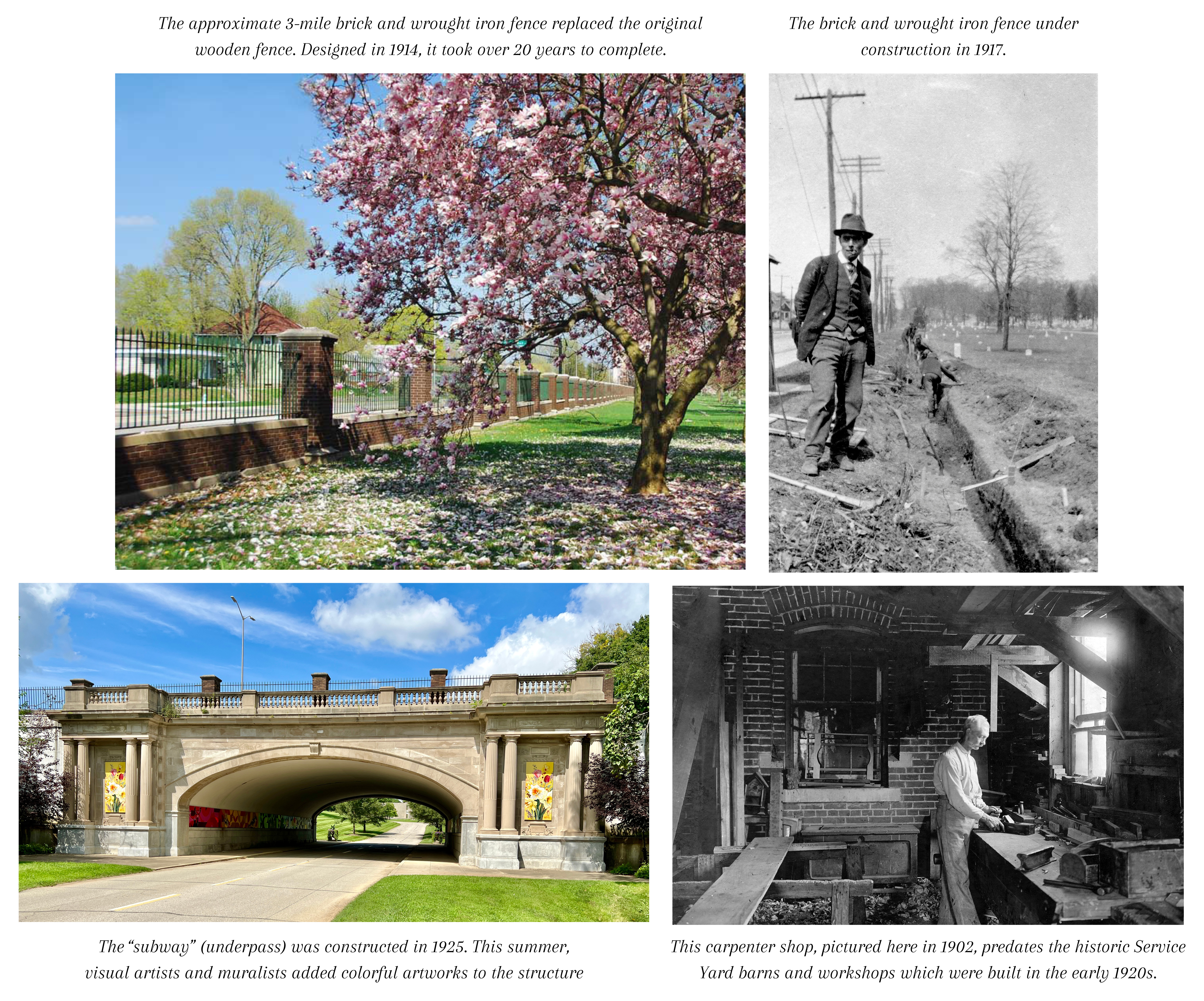 Built of brick and stone in the early 1920s, with numerous wrought iron gates, the Service Yard, Barns, and Workshops continue to function as working spaces, their appearance all but unchanged over time. Along with general-purpose working areas, they housed the Crown Hill workhorses and provided space for a blacksmith’s shop.
Built of brick and stone in the early 1920s, with numerous wrought iron gates, the Service Yard, Barns, and Workshops continue to function as working spaces, their appearance all but unchanged over time. Along with general-purpose working areas, they housed the Crown Hill workhorses and provided space for a blacksmith’s shop.
Crown Hill Cemetery was listed on the National Register of Historic Places in 1973. As we celebrate our 160th anniversary this month, we carry the treasures of our past into the future. This beautiful quote by Marianne W. Tobias, a pianist, musicologist, arts patron, philanthropist, and Crown Hill Corporator until her recent death, still rings true: “Solace lies at the heart of Crown Hill. In the middle of a large, noisy, bustling city, this unique institution stands proudly in its mission. The institution speaks quietly, respectfully, and powerfully of life’s final transition. With its natural beauty and its caring people, Crown Hill is a magical place with an elegant culture, the highest standards and an enduring strength that seems to cleanse death of morbidity, offering hope, acceptance, and peace to all.” (Crown Hill: History |Spirit |Sanctuary, 2013, in celebration of Crown Hill’s 150th anniversary)
Find many of the locations mentioned in this article in our Visitor’s Map & Guide.

